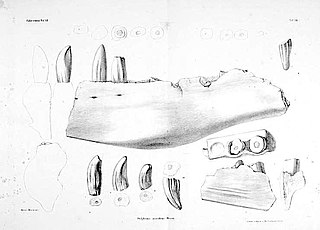
Orcinus is a genus of four species of oceanic dolphins: O. orca, the only extant species, and the three extinct species O. paleorca, O. citoniensis and O. meyeri.

Leptospirosis is a blood infection caused by the bacteria Leptospira. Signs and symptoms can range from none to mild to severe. Weil's disease, the acute, severe form of leptospirosis, causes the infected individual to become jaundiced, develop kidney failure, and bleed. Bleeding from the lungs associated with leptospirosis is known as severe pulmonary haemorrhage syndrome.

The Leptospiraceae are a family of spirochete bacteria. It includes the genus Leptospira which contains some pathogenic species.

Leptospira is a genus of spirochaete bacteria, including a small number of pathogenic and saprophytic species. Leptospira was first observed in 1907 in kidney tissue slices of a leptospirosis victim who was described as having died of "yellow fever".

The white-eared opossum, also known as the timbu, is an opossum species found in Argentina, Bolivia, Brazil, Paraguay, and Uruguay. It is a terrestrial and, sometimes, arboreal animal, and a habitat generalist, living in a wide range of different habitats.

The trefoil-toothed giant rat is a species of rodent in the family Muridae. It is found only in Sulawesi, Indonesia, where it is located throughout the island.
Leptospira noguchii is a gram-negative, pathogenic organism named for Japanese bacteriologist Dr. Hideyo Noguchi who named the genus Leptospira. L. noguchii is famous for causing the febrile illness in Fort Bragg, NC during World War II. There was 40 cases of this fever documented during each summer from 1942 to 1944; however, there were 0 deaths recorded from this outbreak. Unlike other strains of Leptospira that cause leptospirosis, L. noguchii is characterized by showing a pretibial rash on the victim. Its specific epithet recognises Hideyo Noguchi.

Leptospira interrogans is a Gram negative, obligate aerobe spirochete, with periplasmic flagella. When viewed through a dark-field microscope, it often resembles a question mark, and this gives the species its name. It is a member of the genus Leptospira. Some important pathogenic serovars from this species are Canicola, Icterohaemorrhagiae and Australis. L. interrogans is difficult to culture, requiring special media and extended incubation periods.
Leptospira weilii is a pathogenic species of Leptospira.
Leptospira santarosai is a pathogenic species of Leptospira.
Leptospira borgpetersenii is a pathogenic species of Leptospira.
Leptospira wolbachii is a saprophytic species of Leptospira.
Leptospira inadai is a pathogenic species of Leptospira.
Leptospira alexanderi is a species of Leptospira. Its type strain is strain L 60T.
Leptospira fainei is a pathogenic species of Leptospira, first isolated from pigs in Australia and named for University of Otago and Monash University microbiologist Dr. Solomon Faine.
Leptospira kirschneri is a Gram negative, obligate aerobe species of spirochete bacteria named for University of Otago bacteriologist Dr. Leopold Kirschner. It is a member of the genus Leptospira. The species is pathogenic and can cause leptospirosis, most commonly in pigs.

Orcinus meyeri is a contentious fossil species of killer whale found in the Early Miocene deposits of southern Germany, known from two jaw fragments and 18 isolated teeth. It was originally described as Delphinus acutidens in 1859, but reclassified in 1873. Its validity is disputed, and it may be a synonymous with the ancient sperm whale Physeterula dubusi. It was found in the Alpine town of Stockach in the Molasse basin, which was a coastal area with strong tidal currents.

The Marovaza yellow bat or Marovaza house bat is a species of bat found in Madagascar.
Leptospira alstonii is a gram negative, mobile, spirochete. It is flexible, helical, and motile by means of two periplasmic flagella. It is obligately aerobic and oxidase positive. It was named after J. M. Alston, a British microbiologist who made significant contributions to the study of Leptospirosis. It is one of nine human or animal pathogenic species of Leptospira. It was originally isolated from material submitted to the Veterinary Diagnostic Laboratory at Iowa State University during an outbreak of swine abortion in 1983. It has been isolated and stored in liquid nitrogen or Ellinghausen-McCullough-Johnson-Harris medium. It also has been isolated in China from a frog. The strain is also available from culture collections of the WHO collaborating centers. Lipase is not produced by this species. NaCl is not required for growth. Growth is inhibited by 8-azaguanine at 225 µg/mL or 2,6-diaminopurine (10 µg/mL) and copper sulfate. It contains serovars from the serogroup ranarum. DNA G+C content is 39±8 mol%.
Solomon Faine was a New Zealand-born microbiologist known for his research on leptospirosis. With Dr. Leopold Kirschner, Faine made early epidemiologic descriptions of leptospirosis as an occupational disease of dairy farmers in New Zealand. The intermediate Leptospira species Leptospira fainei is named in his honor.






